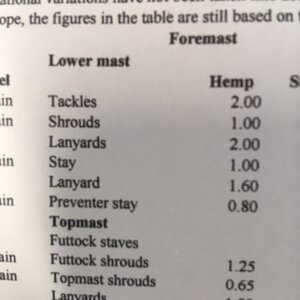I'm using the rigging rope sizes spreadsheet to check rigging diameters.
I'm not clear on which ropes some of the terms are referring to as the sizing doesn't fit with my impression.

Shrouds and stays I get - Tackles? I imagine the lanyards are the lines that go back and forth between the deadeyes, but then why are they larger than the stay/shroud?
Can someone enlighten me? Thanks!
I'm not clear on which ropes some of the terms are referring to as the sizing doesn't fit with my impression.

Shrouds and stays I get - Tackles? I imagine the lanyards are the lines that go back and forth between the deadeyes, but then why are they larger than the stay/shroud?
Can someone enlighten me? Thanks!


